Pros
-
Open soundstage
-
Very comfortable
Cons
-
Not portable
-
Expensive
Introduction
Product Overview
{{section_header}}{{section.name}}{{/section_header}}
Meet the AKG K701s, a set of mid-range semi open-backed over-ears.
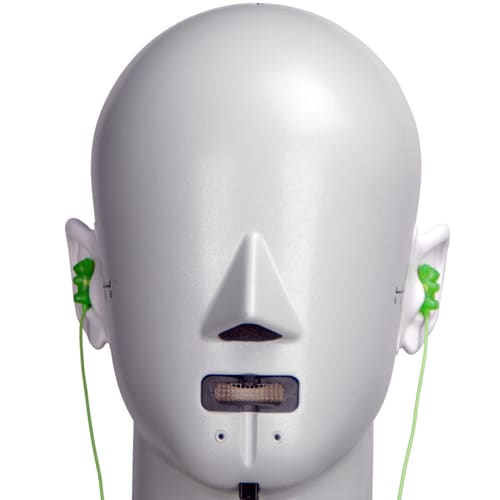
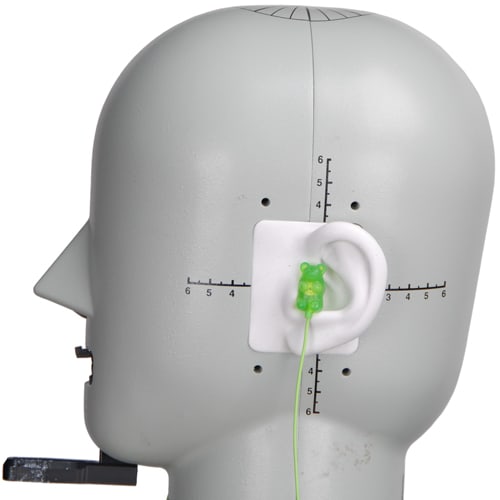
Speakers
{{section_header}}{{section.name}}{{/section_header}}
Here we see the speaker element of the {{product.name}}, which until we stripped the pads off, was guarded by a fine cloth mesh. Also hiding in there was a foam ring to separate the cloth from the speaker element.
Back
{{section_header}}{{section.name}}{{/section_header}}
The {{product.name}}s have semi-open backs to their ear cups, pictured below. Careful, these leak sound.
Band
{{section_header}}{{section.name}}{{/section_header}}
The band of the {{product.name}}s is a little odd, as it uses a system of high-tensile string and a leather strap that moves along guide rails. Despite it being a little unusual when it was released, it does make these cans extremely comfortable.
Cable
{{section_header}}{{section.name}}{{/section_header}}
The {{product.name}}'s cable is 10 feet long, and capped by a straight jack. The cable itself is thick, with very robust insulation on the wire, making for a durable cable.
The plug of the {{product.name}} is a straight 1/4th inch jack, adaptable for 1/8th inch connections. Chances are good that you will probably not use the 1/8th inch jack if you are going to power these headphones properly.
The cord guards on the {{product.name}} seem durable enough, as Harman elected to equip them with thick rubber.
Additional Features
{{section_header}}{{section.name}}{{/section_header}}
Included in the packaging for the {{product.name}} is a stand for your headphones, meant to display your beautiful new cans to anyone entering your room.
In the Box
{{section_header}}{{section.name}}{{/section_header}}
When you open the box of the {{product.name}}s, you'll find your headphones, a stand, a 1/4 to 1/8th inch adapter, and assorted documentation.
Durability
{{section_header}}{{section.name}}{{/section_header}}
While there are no glaring durability issues, we should point out that the {{product.name}}s do not have a removable cable. For that, you'll have to find a retailer that sells the AKG K702s instead, which is seemingly different only by this capability and its padding.
Aesthetics
{{section_header}}{{section.name}}{{/section_header}}
These are slick looking headphones. Don't get us wrong, they're huge, but they are also stylish; enthusiasts of the retro look will love these headphones. Very nice, AKG. If you're willing to shell out a little extra, the new Quincy Jones line of AKG headphones has the K701s (re-branded the Q701s) in lime green, black with green cables, and white with black accents.
Frequency Response
{{section_header}}{{section.name}}{{/section_header}}
Though the frequency response of the {{product.model}}s is a bit more dynamic than we'd like to see, it does manage to stay within our ideal limits extremely well. It has a nice, even bass response, but it does seem to shift the mid tones a bit, emphasizing the 2-4kHz and 7-9kHz ranges. What does this mean for you? Well, in addition to making cymbal attack sounds slightly underemphasized in comparison to the rest of your music, the cymbal shimmer and fricative voice sounds will be marginally louder. Beyond the mid tones, the {{product.model}}s manage to keep some of the high tones before a strange underemphasis at about 14 kHz.
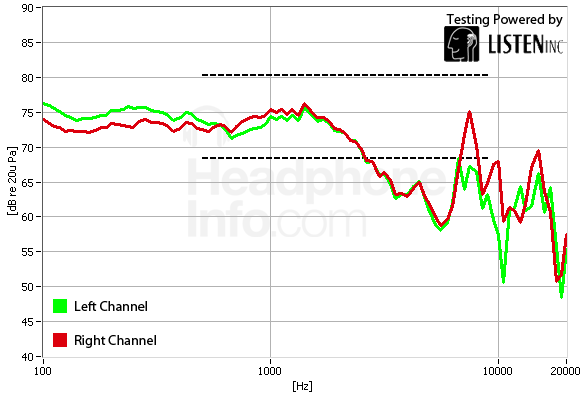
Click here for more information on our frequency response test.
Distortion
{{section_header}}{{section.name}}{{/section_header}}
The {{product.name}}s don't have much distortion, but it's there. Though you will find it quite inaudible, audiophiles will be quick to point out that it's not perfect.
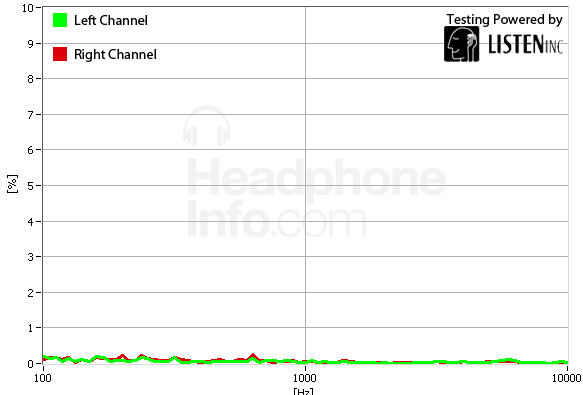
Click here for more information on our frequency response test.
Tracking
{{section_header}}{{section.name}}{{/section_header}}
We were a bit surprised to see that the {{product.name}}s had such an erratic tracking response, but all in all it's not as bad as it looks. Most of the shifts in channel preference are less than 2dB, which is nigh inaudible. It's not perfect, but it's far from the worst response we've seen from high-end headphones.
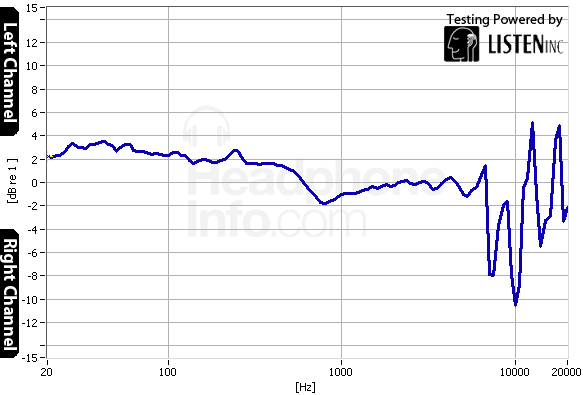
Click here for more information on our frequency response test.
Isolation
{{section_header}}{{section.name}}{{/section_header}}
Let's get this out of the way up-front: the {{product.name}}s are awful at isolation. They're not really meant to attenuate noise, though. Open-backed headphones may not be great isolators, but they do provide an open soundstage for those who prefer one over that of closed-back headphones. This does have huge implications for isolation, as they let in almost every outside sound (as well as moisture) due to the open backs. Do not take these out in public.
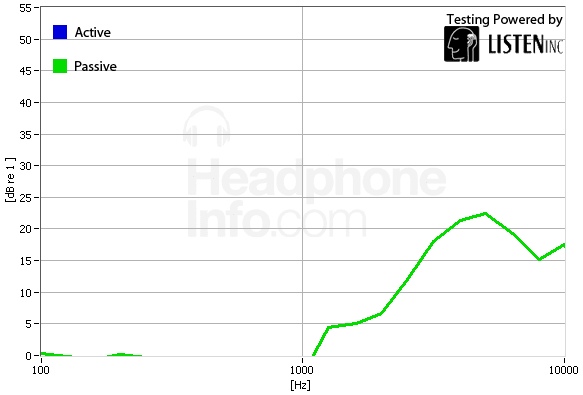
Click here for more information on our isolation test.
Leakage
{{section_header}}{{section.name}}{{/section_header}}
The open backs pose a problem for leakage, too. The {{product.name}}s leak a ton of sound into the outside world through their backs. Unless these are turned down to a whisper, you will annoy those around you with the sound of your music.
Click here for more information on our leakage test.
Maximum Usable Volume
{{section_header}}{{section.name}}{{/section_header}}
While the {{product.name}}s have a somewhat low maximum usable volume of 99 dB, it's not as bad as it sounds. Headphones that can reach 120dB without 3% distortion score the highest marks in this category, but there's really no reason why you should ever be listening to cans at this volume. In fact, if you do, there's a very good chance that you'll damage your hearing irreparably. Sure, these headphones let in a lot of noise, and you may be tempted to boost your volume to drown it out, but if you're in a loud environment, you really should be reconsidering open-backed headphones like the {{product.name}}. If you'd like to know more about Noise-Induced Hearing Loss, check out our page on the condition.
Click here for more on our maximum usable volume test
Short-Term Use
{{section_header}}{{section.name}}{{/section_header}}
The interesting band of the {{product.name}}s provide for a rather comfortable listening experience, as the headphones don't seem to put too much pressure on your head, though they do grip it firmly. The thick padding and huge area of contact distribute their weight well, though you won't forget that you have them on your head.

Extended Use
{{section_header}}{{section.name}}{{/section_header}}
Over time, the {{product.name}}s don't feel any less comfortable, they don't get hot, and they don't pinch your pinna. As far as over-ears go, these are some of the most comfortable you can find.
Customizability
{{section_header}}{{section.name}}{{/section_header}}
Aside from removing the little foam bits underneath your ear pads, there really isn't anything you can do to customize your {{product.name}}s. Still, we can't imagine what you'd really want to do to cans this pretty.
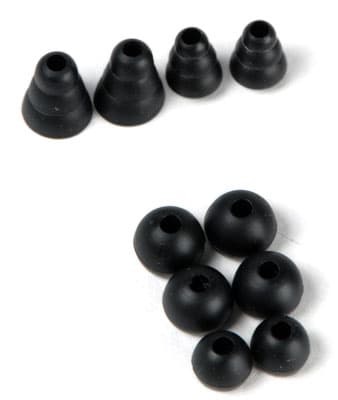
Cable Connectivity
{{section_header}}{{section.name}}{{/section_header}}
The plug of the {{product.name}}s is a rather bland 1/4th inch jack, but some users from the iPod generation may find this a bit clunky to use. So, to make use even clunkier, they've added a 1/4th to 1/8th inch adapter. Though you'll be able to connect to your iPod with this abomination of a plug, we suggest sticking to sources that require the 1/4th inch plug because these cans take a lot of power to drive. Without a proper amp, you won't be able to power them properly.
Portability
{{section_header}}{{section.name}}{{/section_header}}
These cans were not made to go outside. With their open backs, inability to survive normal weather, and gigantic cable, we don't see these becoming a regular sight on the streets. We don't recommend you try this either. If you do need to get them from one place to another, we suggest finding a good case to put them in before carting them away.
Maintenance
{{section_header}}{{section.name}}{{/section_header}}
Outside of being able to clean the cloth part above the speaker element, there really isn't much you can do to maintain your {{product.name}}s. The {{product.model}}'s sister model, the K702, has the ability to recable your cans should they get damaged, so if you would like this capability, be prepared to shell out a couple extra bucks for this.
Other Features
{{section_header}}{{section.name}}{{/section_header}}
The {{product.name}}s don't have any other features worthy of note, outside of a stand for your headphones.
Design
{{section_header}}{{section.name}}{{/section_header}}
Both headphones are stylish, and the retro enthusiast may love the {{product.name}}s more than the HD 800s, but we'd like to point out that the Sennheiser flagship over-ears have one thing that the {{product.name}}s don't: removable/replaceable cables. Speaking from a durability standpoint, this is huge. Should anything happen to your cables as an HD 800 owner, all you have to do is send out for new ones, and your cans are salvaged. Not so with the {{product.name}}s.
Frequency Response
{{section_header}}{{section.name}}{{/section_header}}
When you get to a certain level of headphone, the differences in frequency response become more a matter of taste than anything else. The HD 800s keep a very flat response throughout, and stay within our ideal limits very well. The {{product.name}}s do this as well, though you can see some of its tracking issues rear its ugly head here. That being said, the {{product.name}}s maintain more of the higher frequencies than the HD 800s, even if the Sennheisers have better tracking. The {{product.name}}s also hug the upper limit of our ideal range, meaning your music will get a good boost from these cans... if you can sate their huge appetite for power.
Distortion
{{section_header}}{{section.name}}{{/section_header}}
Neither set of cans has any troubling concerns with distortion, but the {{product.name}}s technically have more. Still, this is well below what normal humans can hear, so fear not.
Tracking
{{section_header}}{{section.name}}{{/section_header}}
Here's where the HD 800s blow the {{product.name}}s out of the water. Though the imperfections in the {{product.name}}'s tracking response are barely noticeable at worst, the HD 800s are nearly ideal here.
Isolation
{{section_header}}{{section.name}}{{/section_header}}
Neither set of cans were made to attenuate noise, so it's no surprise that neither isolate well. Both leak sound like sieves.
Comfort
{{section_header}}{{section.name}}{{/section_header}}
Both headphones are insanely comfortable to wear, and you really can't go wrong with either.
Verdict
{{section_header}}{{section.name}}{{/section_header}}
This one's a tough one. Though the HD 800s seem to perform better in a few key areas, the step up from the {{product.name}}s is actually not that large by judging the frequency response, distortion and tracking alone. Currently there's no test for clarity of sound, so we can't make that comparison objectively. Differences in the performances we measured will be only slightly audible at best. Though it really depends on what you're looking for in headphones, the difference in price may be enough to dissuade some more economically-minded audiophiles away from the HD 800s with their giant pricetag.
Design
{{section_header}}{{section.name}}{{/section_header}}
One of the major differences in design between the ATH-M50s and the {{product.name}}s is the closed back sported by the Audio Technicas. While this isn't the most dramatic change in headphone design, there are some tradeoffs that come with it, namely the increased durability, the possibility of tiny echoes, and the ability to leave the computer. The {{product.name}}s do look pretty sweet, though.
Frequency Response
{{section_header}}{{section.name}}{{/section_header}}
The {{product.name}}s take this one hands-down if you're an audiophile, but for the average consumer, the ATH-M50s actually do fairly well here by boosting bass frequencies a bit, and almost keeping its response within our ideal limits. It does have that bizarre underemphasis in the 4-8kHz range though, meaning cymbals are strangely muffled a bit.
Distortion
{{section_header}}{{section.name}}{{/section_header}}
Perhaps the one area that the ATH-M50s excel in is the near complete lack of distortion. They take this one.
Tracking
{{section_header}}{{section.name}}{{/section_header}}
Neither cans were perfect here, but the ATH-M50s were less erratic, even if they technically didn't score as well as the {{product.name}}s.
Isolation
{{section_header}}{{section.name}}{{/section_header}}
Because the {{product.name}}s weren't made to attenuate noise, it's no surprise that they don't manage to keep as much sound from the outside world out all that well. That being said, do not wear either of these cans thinking they will attenuate much noise at all. Both are bad at it.
Comfort
{{section_header}}{{section.name}}{{/section_header}}
Before you decide on a pair of headphones you like, we always urge you to try them on before you buy if you have the opportunity. Because both of these cans are very comfortable, you'll have to decide what's best for you. As a side note for those of you with larger heads, the {{product.name}}s fared much better in the eyes of co-workers here at the office that had medium to large craniums.
Verdict
{{section_header}}{{section.name}}{{/section_header}}
The {{product.name}}s are better for the computer or studio-bound audiophile, while the ATH-M50s are great for entry-level customers looking for a step above what they may be used to with Beats or other popular headphones. Still, because situations change and accidents happen, we encourage users who have not had time with studio-styled headphones to check out closed-back headphones first, especially if they want to take their cans on the go.
Design
{{section_header}}{{section.name}}{{/section_header}}
We don't need to tell you that open-backed over-ears are very different by design from in-ears, but when shopping for headphones it's necessary to explore your options so you don't miss out on something. Though they're quite ugly compared to the {{product.name}}s, the Shure SE535s offer some key advantages in durability. For example, the detachable earbuds allow you to re-cable your headphones if the cables break for whatever reason. In addition, they can go outside, whereas the {{product.name}}s cannot.
Frequency Response
{{section_header}}{{section.name}}{{/section_header}}
The {{product.name}}s take this one, as they stay within our ideal limits much better than the Shures, which seem to mute much of their high end considerably.
Distortion
{{section_header}}{{section.name}}{{/section_header}}
The Shures seem to have more distortion in general, but nothing that should be too noticeable. Both headphones don't have much in the way of distortion.
Tracking
{{section_header}}{{section.name}}{{/section_header}}
Though neither response is perfect, the Shures have a near-ideal response in terms of tracking, where the {{product.name}}s are a bit erratic.
Isolation
{{section_header}}{{section.name}}{{/section_header}}
Because in-ear headphones often rely on creating a seal inside your ear canal, it's not very surprising that the SE535s isolate far more noise than do the {{product.name}}s, which weren't designed to attenuate much noise at all.
Comfort
{{section_header}}{{section.name}}{{/section_header}}
Another area in which type of design is extremely important is comfort. Though everyone as different heads and ears, on the whole in-ears tend to be far less comfortable than over-ear headphones, as they penetrate a small orifice that was not designed to have anything in it, save for some earwax on occasion. Still, if you can, try both on before you buy to determine when suits you best.
Verdict
{{section_header}}{{section.name}}{{/section_header}}
If you like over-ears, we're going to stick with the {{product.name}}s here. Not only are they super-comfortable, but they also have great audio performance, which the Shures lack a bit in frequency response and distortion, not to mention comfort. If you prize durability and portability, however, it's very hard to argue with that the SE535s provide you as a consumer, so check both out before you by, if you can.
Design
{{section_header}}{{section.name}}{{/section_header}}
By design, these headphones are very similar: they're both open-backed, they're both over-ear cans, and they both employ dynamic drivers. Neither has detachable cables, but both have a considerable amount of padding on the ear cups. From an aesthetic standpoint, the DT 990 Pros may appeal to you if you don't like flashy headphones, but the {{product.name}}s are slick-looking cans that are quite beautiful.
Frequency Response
{{section_header}}{{section.name}}{{/section_header}}
Where the {{product.name}}s have a somewhat dynamic but still ideal frequency response, that of the Beyerdynamics is very flat, with the slightest emphasis on bass frequencies. At this performance level, frequency response becomes more of a matter of taste, as both are well within our ideal limits, but the DT 990 PROs have a boost in the 9.5-10.5kHz range that's a little hard to ignore. Though the {{product.name}}s scored higher here, try each to make sure you're getting what you want in your cans.
Distortion
{{section_header}}{{section.name}}{{/section_header}}
Though neither set of cans had much in the way of distortion, the Beyerdynamics have a much lower total SPL, and virtually no distortion to speak of.
Tracking
{{section_header}}{{section.name}}{{/section_header}}
The tracking response of the DT 990 PROs is much flatter, save for the highest end. Clear winner here, though the {{product.name}}'d shifts in channel preference are nigh-inaudible at worst.
Isolation
{{section_header}}{{section.name}}{{/section_header}}
Neither set of cans was designed to attenuate noise, so this is a somewhat useless comparison. Neither block out much sound at all.
Comfort
{{section_header}}{{section.name}}{{/section_header}}
Though both of these headphones are comfortable in the short run, the DT 990 PROs have a tendency to dig into your skull at the band over time. The band of the {{product.name}}s, on the other hand, meet your skull with a huge surface area, distributing the weight evenly over your cranium efficiently and comfortably over long periods of time.
Verdict
{{section_header}}{{section.name}}{{/section_header}}
This is somewhat of a wash, really. Where the {{product.name}}s are more comfortable, and have a tighter frequency response, the DT 990 PROs have a flatter frequency repsonse, as well as near-perfect tracking and almost no distortion whatsoever. DO yourself a favor and check both of these out if you get the chance to see what you'd prefer.
Conclusion
{{section_header}}{{section.name}}{{/section_header}}
Though the purpose of this review was more to build a bank of headphones to compare open-backed cans to compare to in the future, the {{product.name}} introduced in 2007 are still impressive to this day. With a great frequency response, extremely comfortable wear and open soundstage, these are a good entry to mid-level pickup for those who are fans of an analytical sound. Though these headphones have more or less been re-born through re-branding as the AKG Q701s, the addition of flashy colors and a new title haven't changed their good performance. They aren't meant to go outside with, but audio nerds chained to their desks will love these headphones.
Meet the tester
A seasoned writer and professional photographer, Chris reviews cameras, headphones, smartphones, laptops, and lenses. Educated in Political Science and Linguistics, Chris can often be found building a robot army, snowboarding, or getting ink.
Checking our work.
Our team is here to help you buy the best stuff and love what you own. Our writers, editors, and experts obsess over the products we cover to make sure you're confident and satisfied. Have a different opinion about something we recommend? Email us and we'll compare notes.
Shoot us an email